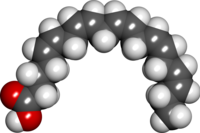Eicosapentaenoic acid/ja: Difference between revisions
Created page with "海洋細菌であるシェワネラ(''Shewanella'')が提唱するEPAのポリケチド合成経路は、アセチルCoAとマロニルCoAを構成要素として、還元、脱水、縮合を繰り返す反応である。α-リノレン酸からEPAへの変換機構は、KSによって既存のα-リノレン酸にマロニルCoAが縮合する。得られた構造は、NADPH依存性還元酵素KRによって変換され、DH酵素によって脱水された中間..." |
Created page with "==臨床的意義{{Anchor|Clinical significance}}== {{Further/ja|Essential fatty acid interactions/ja}} thumb|right|250px|[[salmon/ja|サーモンはEPAの豊富な供給源である。]] 米国国立衛生研究所のMedlinePlusには、EPA(単独または他のω-3源と併用)が効果的な治療法であることが知られている、または考えられている病状が掲載されて..." Tags: Mobile edit Mobile web edit |
||
| Line 104: | Line 104: | ||
{{clear}} | {{clear}} | ||
==臨床的意義{{Anchor|Clinical significance}}== | |||
==Clinical significance== | {{Further/ja|Essential fatty acid interactions/ja}} | ||
{{Further|Essential fatty acid interactions}} | [[File:Röding, Iduns kokbok.jpg|thumb|right|250px|[[salmon/ja|サーモン]]はEPAの豊富な供給源である。]] | ||
[[File:Röding, Iduns kokbok.jpg|thumb|right|250px|[[ | 米国[[:en:National Institute of Health|国立衛生研究所]]のMedlinePlusには、EPA(単独または他のω-3源と併用)が効果的な治療法であることが知られている、または考えられている病状が掲載されている。これらのほとんどは、[[inflammation/ja|炎症]]を低下させるその能力に関わっている。 | ||
<div lang="en" dir="ltr" class="mw-content-ltr"> | <div lang="en" dir="ltr" class="mw-content-ltr"> | ||
Revision as of 20:35, 14 April 2024

| |
| Names | |
|---|---|
| Preferred IUPAC name
(5Z,8Z,11Z,14Z,17Z)-Icosa-5,8,11,14,17-pentaenoic acid | |
| Other names
(5Z,8Z,11Z,14Z,17Z)-5,8,11,14,17-eicosapentaenoic acid
| |
| Identifiers | |
3D model (JSmol)
|
|
| 3DMet | |
| 1714433 | |
| ChEBI | |
| ChEMBL | |
| ChemSpider | |
| DrugBank | |
| KEGG | |
PubChem CID
|
|
| UNII | |
| |
| |
| Properties | |
| C20H30O2 | |
| Molar mass | 302.451 g/mol |
| Hazards | |
| GHS labelling: | |

| |
| Danger | |
| H314 | |
| P260, P264, P280, P301+P330+P331, P303+P361+P353, P304+P340, P305+P351+P338, P310, P321, P363, P405, P501 | |
エイコサペンタエン酸(EPA、icosapentaenoic acid)は、オメガ3脂肪酸の一種である。生理学的な文献では20:5(n-3)と呼ばれている。また、慣用名としてチムノドン酸がある。化学構造では、EPAは20炭素鎖と5つのシスを持つカルボン酸二重結合はω末端から3番目の炭素に位置する。
EPAは、プロスタグランジン-3(血小板凝集を抑制する)、トロンボキサン-3、ロイコトリエン-5の前駆体として働く多価不飽和脂肪酸(PUFA)である。エイコサノイド類である。EPAは前駆体であると同時に加水分解物質でもある。エイコサペンタエノイルエタノールアミド(EPEA:C22H35NO2; 20:5,n-3)の分解産物である。 ドコサヘキサエン酸(DHA)とEPAの両方を含む魚油サプリメントの研究では、心筋梗塞や脳卒中を予防するという主張を裏付けることはできなかったが、バセパ(エチルエイコサペンタエン酸、エチルエステル、遊離脂肪酸エステル)、EPAのみを含む処方薬物であるが、スタチン抵抗性高トリグリセリド血症の患者において、プラセボと比較して心臓発作、脳卒中、心血管死を25%減少させることが示された。
摂取源
EPAは、タラ肝、ニシン、サバ、サケ、メンヘデン、イワシなどの脂ののった魚、さまざまな種類の食用藻類を食べることによって、あるいは魚油や藻類油のサプリメントを摂取することによって、ヒトの食事から得られる。また、ヒトの母乳にも含まれている。
魚類はほとんどの脊椎動物と同様に、食餌性のα-リノレン酸(ALA)からEPAをほとんど合成できない。このように変換率が極めて低いため、魚類は主に摂取した藻類からEPAを摂取している。EPAは動物以外からも摂取可能である(例えば、Yarrowia lipolyticaやNannochloropsis oculata、Monodus subterraneus、Chlorella minutissima、Phaeodactylum tricornutumなどの微細藻類が商業的に開発されている)。EPAは通常、高等植物には含まれていないが、パースレーンには微量含まれていることが報告されている。2013年には、カメリーナという植物の遺伝子組み換え体から、かなりの量のEPAが生産されることが報告された。
ヒトの体内では、吸収されたα-リノレン酸(ALA)の一部がEPAに変換される。ALAはそれ自体が必須脂肪酸であり、ヒトは適切な供給を必要としている。しかし、ALAからEPAへの変換効率は、EPAを含む食品からのEPAの吸収に比べるとはるかに低い。EPAはドコサヘキサエン酸(DHA)の前駆体でもあるため、EPAもDHAも含まない食事で十分なEPA量を確保することは、EPAを合成するために必要な余分な代謝作業と、DHAへの代謝にEPAを使用するため、どちらも難しくなる。また、糖尿病や特定のアレルギーのような医薬品は、人体がALAからEPAを代謝する能力を著しく制限する可能性がある。
形態
市販されている栄養補助食品は、魚油由来のものが最も多く、トリグリセリド型、エチルエステル型、リン脂質型のEPAが一般的である。サプリメントメーカーの間では、各形態の相対的な長所と短所について議論が交わされている。藻類に天然に存在する極性脂質の形態は、エチルエステルやトリグリセリドの形態よりも生物学的利用能が向上していることが示されている。同様に、2020年の研究では、リゾホスファチジルコリン(LPC)形態のDHAまたはEPAは、トリグリセリドおよびホスファチジルコリン(PC)よりも効率的であることが判明した。
| ベース | EPA |
|---|---|
| エチルエステル | EPAエチルエステル |
| Lysophosphatidylcholine/ja (LPC, あるいは lysoPC) | LPC-EPA, あるいは lysoPC-EPA |
| Phosphatidylcholine/ja (PC) | EPA-PC |
| Phospholipid/ja (PL) | EPA-PL |
| トリグリセリド (TG) あるいは トリアシルグリセロール (TAG) | EPA-TG, あるいは EPA-TAG |
| 再エステル化トリグリセリド(rTG)、または再エステル化トリアシルグリセロール(rTAG) | EPA rTG, あるいは r-TAG |
生合成
好気性真核生物による経路

好気性真核生物、具体的には微細藻類、コケ類、菌類、およびほとんどの動物(ヒトを含む)は、通常、デサチュラーゼとエロンガーゼ酵素の連続的な作用によって触媒される一連の脱飽和反応と伸長反応としてEPAの生合成を行う。もともとThraustochytriumで同定されたこの経路は、これらのグループに当てはまる:
- Δ6デサチュラーゼによってα-リノレン酸の6番目の炭素で脱飽和が起こり、ステアリドン酸(SDA、18:4 ω-3)が生成される、
- Δ6エロンガーゼによってステアリドン酸が伸長され、エイコサテトラエン酸(ETA、20:4 ω-3)が生成される、
- Δ5デサチュラーゼによってエイコサテトラエン酸の5番目の炭素で脱飽和し、エイコサペンタエン酸(EPA、20:5 ω-3)を生成する、
ポリケチド合成酵素経路
海洋細菌や微細藻類Schizochytriumは、好気性ポリケチド合成酵素(PKS)経路を用いてDHAを合成する。PKS経路には6つの酵素、すなわち3-ケトアシルシンターゼ(KS)、2-ケトアシル-ACP-レダクターゼ(KR)、デヒドラーゼ(DH)、エノイルレダクターゼ(ER)、デヒドラターゼ/2-トランス 3-cosイソメラーゼ(DH/2,3I)、デヒドラターゼ/2-トランス、2-cisイソメラーゼ(DH/2,2I)が含まれる。EPAの生合成は海洋種によって異なるが、C18PUFAをLC-PUFAに変換する海洋種の能力のほとんどは、脂肪アシルデサチュラーゼとエロンガーゼ酵素に依存している。酵素の分子基盤は、得られる分子上の二重結合が形成される場所を決定する。
海洋細菌であるシェワネラ(Shewanella)が提唱するEPAのポリケチド合成経路は、アセチルCoAとマロニルCoAを構成要素として、還元、脱水、縮合を繰り返す反応である。α-リノレン酸からEPAへの変換機構は、KSによって既存のα-リノレン酸にマロニルCoAが縮合する。得られた構造は、NADPH依存性還元酵素KRによって変換され、DH酵素によって脱水された中間体を形成する。最終段階は、ER酵素活性によってトランス-2-エノリ-ACPの二重結合がNADPH依存的に還元される。この過程を繰り返してEPAが形成される。
臨床的意義

米国国立衛生研究所のMedlinePlusには、EPA(単独または他のω-3源と併用)が効果的な治療法であることが知られている、または考えられている病状が掲載されている。これらのほとんどは、炎症を低下させるその能力に関わっている。
Intake of large doses (2.0 to 4.0 g/day) of long-chain omega-3 fatty acids as prescription drugs or dietary supplements are generally required to achieve significant (> 15%) lowering of triglycerides, and at those doses the effects can be significant (from 20% to 35% and even up to 45% in individuals with levels greater than 500 mg/dL).
Dietary supplements containing EPA and DHA lower triglycerides in a dose dependent manner; however, DHA appears to raise low-density lipoprotein (the variant which drives atherosclerosis, sometimes inaccurately called "bad cholesterol") and LDL-C values (a measurement/estimate of the cholesterol mass within LDL-particles), while EPA does not. This effect has been seen in several meta-analyses that combined hundreds of individual clinical trials in which both EPA and DHA were part of a high dose omega-3 supplement, but it is when EPA and DHA are given separately that the difference can be seen clearly. For example, in a study by Schaefer and colleagues of Tufts Medical School, patients were given either 600 mg/day DHA alone, 600 or 1800 mg/day EPA alone, or placebo for six weeks. The DHA group showed a significant 20% drop in triglycerides and an 18% increase in LDL-C, but in the EPA groups modest drops in triglyceride were not considered statistically significant and no changes in LDL-C levels were found with either dose.
Ordinary consumers commonly obtain EPA and DHA from foods such as fatty fish,[lower-alpha 1] fish oil dietary supplements, and less commonly from algae oil supplements in which the omega-3 doses are lower than those in clinical experiments. A Cooper Center Longitudinal Study that followed 9253 healthy men and women over 10 years revealed that those who took fish oil supplements did not see raised LDL-C levels. In fact, there was a very slight decrease of LDL-C which was statistically significant but too small to be of any clinical significance. These individuals took fish oil supplements of their own choosing, and it should be recognized that the amounts and ratios of EPA and DHA vary according to the source of fish oil.
Omega-3 fatty acids, particularly EPA, have been studied for their effect on autistic spectrum disorder (ASD). Some have theorized that, since omega-3 fatty acid levels may be low in children with autism, supplementation might lead to an improvement in symptoms. While some uncontrolled studies have reported improvements, well-controlled studies have shown no statistically significant improvement in symptoms as a result of high-dose omega-3 supplementation.
In addition, studies have shown that omega-3 fatty acids may be useful for treating depression.
EPA and DHA ethyl esters (all forms) may be absorbed less well, thus work less well, when taken on an empty stomach or with a low-fat meal.
注釈
- ↑ Cooked salmon contain 500–1,500 mg DHA and 300–1,000 mg EPA per 100 grams of fish. See page: Salmon as food.
外部リンク
- EPA bound to proteins in the PDB
- Eicosapentaenoyl Ethanolamide; アナンダミド (20:5, n-3); EPEA. - PubChem